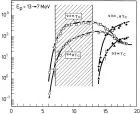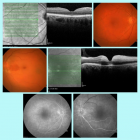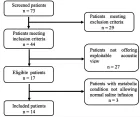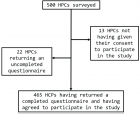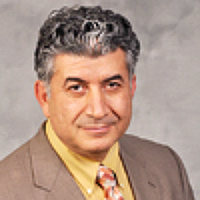Abstract
Research Article
Association between obesity profile and non-alcoholic fatty liver by race/ethnicity
Martin Galindo, Katrina M Schrode and Magda Shaheen*
Published: 19 January, 2021 | Volume 5 - Issue 1 | Pages: 001-010
NAFLD is characterized by accumulation of fat in the liver that can lead to health complications. Previous studies have found the obesity phenotype and its components to be risk factors for the development of NAFLD. This study aims to examine the relationship between the obesity phenotype and NAFLD among each racial-ethnic group. We analyzed data from the NHANES III survey (1988-1994). The obesity phenotype was defined based on BMI and metabolic syndrome. NAFLD was defined by abdominal ultrasounds among non-alcoholics with no infection or taking drugs affecting the liver. A higher prevalence of NAFLD was found among the metabolically unhealthy obese group (43.1%) and the metabolically unhealthy overweight (29.4%) than the metabolically unhealthy normal weight (11.8%). Mexicans-Americans had higher odds of NAFLD relative to whites (adjusted odds ratio (AOR) = 1.3, 95% confidence interval (CI) = 1.01-1.9, p = 0.04). The metabolically healthy obese phenotype was associated with NAFLD (p > 0.05) in the overall sample and in Whites. The metabolically healthy overweight was associated with NAFLD only among Mexican-American (p < 0.05). Metabolically unhealthy overweight or obese had higher odds of NAFLD relative to the metabolically healthy normal weight and this relation is consistent in all the racial/ethnic groups (p < 0.05). Metabolically healthy overweight and obese individuals had a high chance of NAFLD and it varied by race/ethnicity. Healthcare providers should pay more attention to care for those who are part of the metabolically healthy overweight or obese group especially among the Mexican-American population.
Read Full Article HTML DOI: 10.29328/journal.acem.1001017 Cite this Article Read Full Article PDF
References
- Dietrich P, Hellerbrand C. Non-alcoholic fatty liver disease, obesity and the metabolic syndrome. Best Pract Res Clin Gastroenterol. 2014; 28: 637-653. PubMed: PubMed: https://pubmed.ncbi.nlm.nih.gov/25194181/
- Chalasani N, Younossi Z, Lavine JE, Charlton M, Cusi K, et al. The diagnosis and management of nonalcoholic fatty liver disease: Practice guidance from the American Association for the Study of Liver Diseases. Hepatology. 2018; 67: 328-357. PubMed: PubMed: https://pubmed.ncbi.nlm.nih.gov/28714183/
- Anstee QM, Targher G, Day CP. Progression of NAFLD to diabetes mellitus, cardiovascular disease or cirrhosis. Nat Rev Gastroenterol Hepatol. 2013; 10: 330-344. PubMed: PubMed: https://pubmed.ncbi.nlm.nih.gov/23507799/
- Kim HJ, Kim HJ, Lee KE, Kim DJ, Kim SK, et al. Metabolic significance of nonalcoholic fatty liver disease in nonobese, nondiabetic adults. Arch Intern Med. 2004; 164: 2169-2175. PubMed: PubMed: https://pubmed.ncbi.nlm.nih.gov/15505132/
- Marchesini G, Marzocchi R. Metabolic syndrome and NASH. Clin Liver Dis. 2007; 11: 105-117. PubMed: PubMed: https://pubmed.ncbi.nlm.nih.gov/17544974/
- Lonardo A, Ballestri S, Marchesini G, Angulo P, Loria P. Nonalcoholic fatty liver disease: a precursor of the metabolic syndrome. Digestive and Liver Disease. 2015; 47: 181-190. PubMed: PubMed: https://pubmed.ncbi.nlm.nih.gov/25739820/
- Marchesini G, Bugianesi E, Forlani G, Cerrelli F, Lenzi M, et al. Nonalcoholic fatty liver, steatohepatitis, and the metabolic syndrome. Hepatology. 2003; 37: 917-923. PubMed: https://pubmed.ncbi.nlm.nih.gov/12668987/
- Cotrim HP, Parise ER, Oliveira CP, Leite N, Martinelli A, et al. Nonalcoholic fatty liver disease in Brazil. Clinical and histological profile. Ann Hepatol. 2011; 10: 33-37. PubMed: https://pubmed.ncbi.nlm.nih.gov/21301007/
- Goossens GH. The Metabolic Phenotype in Obesity: Fat Mass, Body Fat Distribution, and Adipose Tissue Function. Obes Facts. 2017; 10: 207-215. PubMed: https://pubmed.ncbi.nlm.nih.gov/28564650/
- Park J, Kim SH, Cho GY, Baik I, Kim NH, et al. Obesity phenotype and cardiovascular changes. J Hypertens. 2011; 29: 1765-1772. PubMed: https://pubmed.ncbi.nlm.nih.gov/21826021/
- Meigs JB, Wilson PW, Fox CS, Vasan RS, Nathan DM, et al. Body mass index, metabolic syndrome, and risk of type 2 diabetes or cardiovascular disease. J Clin Endocrinol Metabol. 2006; 91: 2906-2912. PubMed: https://pubmed.ncbi.nlm.nih.gov/16735483/
- Kabootari M, Akbarpour S, Azizi F, Hadaegh F. Sex specific impact of different obesity phenotypes on the risk of incident hypertension: Tehran lipid and glucose study. Nutrition Metabol. 2019; 16: 16.
- Chang Y, Jung HS, Yun KE, Cho J, Ahn J, et al. Metabolically healthy obesity is associated with an increased risk of diabetes independently of nonalcoholic fatty liver disease. Obesity. 2016; 24: 1996-2003. PubMed: https://pubmed.ncbi.nlm.nih.gov/27474900/
- Shaharyar S, Roberson LL, Jamal O, Younus A, Blaha MJ, et al. Obesity and metabolic phenotypes (metabolically healthy and unhealthy variants) are significantly associated with prevalence of elevated C-reactive protein and hepatic steatosis in a large healthy Brazilian population. J Obes. 2015; 2015. 178526. PubMed: https://pubmed.ncbi.nlm.nih.gov/25838943/
- Sinn DH, Gwak GY, Park HN, Kim JE, Min YW, et al. Ultrasonographically detected non-alcoholic fatty liver disease is an independent predictor for identifying patients with insulin resistance in non-obese, non-diabetic middle-aged Asian adults. Am J Gastroenterol. 2012; 107: 561-567. PubMed: https://pubmed.ncbi.nlm.nih.gov/22108448/
- Stefan N, Schick F, Haering HU. Causes, characteristics, and consequences of metabolically unhealthy normal weight in humans. Cell Metabol. 2017; 26: 292-300. PubMed: https://pubmed.ncbi.nlm.nih.gov/28768170/
- Younossi Z, Anstee QM, Marietti M, Hardy T, Henry L, et al. Global burden of NAFLD and NASH: trends, predictions, risk factors and prevention. Nat Rev Gastroenterol Hepatol. 2018; 15: 11-20. PubMed: https://pubmed.ncbi.nlm.nih.gov/28930295/
- Younossi ZM, Stepanova M, Negro F, Hallaji S, Younossi Y, et al. Nonalcoholic fatty liver disease in lean individuals in the United States. Medicine (Baltimore). 2012; 91: 319-327. PubMed: https://pubmed.ncbi.nlm.nih.gov/23117851/
- Browning JD, Kumar KS, Saboorian MH, Thiele DL. Ethnic differences in the prevalence of cryptogenic cirrhosis. Am J Gastroenterol. 2004; 99: 292-298. PubMed: https://pubmed.ncbi.nlm.nih.gov/15046220/
- Rich NE, Oji S, Mufti AR, Browning JD, Parikh ND, et al. Racial and Ethnic Disparities in Nonalcoholic Fatty Liver Disease Prevalence, Severity, and Outcomes in the United States: A Systematic Review and Meta-analysis. Clin Gastroenterol Hepatol. 2018; 16: 198-210. PubMed: https://pubmed.ncbi.nlm.nih.gov/28970148/
- Romeo S, Kozlitina J, Xing C, Pertsemlidis A, Cox D, et al. Genetic variation in PNPLA3 confers susceptibility to nonalcoholic fatty liver disease. Nat Genet. 2008; 40: 1461-1465. PubMed: https://pubmed.ncbi.nlm.nih.gov/18820647/
- Petersen R, Pan L, Blanck HM. Peer Reviewed: Racial and Ethnic Disparities in Adult Obesity in the United States: CDC’s Tracking to Inform State and Local Action. Prevent Chronic Dis. 2019; 16: E46. PubMed: https://pubmed.ncbi.nlm.nih.gov/30974071/
- Ford ES, Giles WH, Dietz WH. Prevalence of the Metabolic Syndrome Among US AdultsFindings From the Third National Health and Nutrition Examination Survey. JAMA. 2002; 287: 356-359. PubMed: https://pubmed.ncbi.nlm.nih.gov/11790215/
- Heiss G, Snyder ML, Teng Y, Schneiderman N, Llabre MM, et al. Prevalence of Metabolic Syndrome Among Hispanics/Latinos of Diverse Background: The Hispanic Community Health Study/Study of Latinos. Diabetes Care. 2014; 37: 2391-2399. PubMed: https://pubmed.ncbi.nlm.nih.gov/25061141/
- Ervin RB. Prevalence of metabolic syndrome among adults 20 years of age and over, by sex, age, race and ethnicity, and body mass index; United States. 2003-2006. Natl Health Stat Report. 2009; 5: 1-7. PubMed: https://pubmed.ncbi.nlm.nih.gov/19634296/
- World Medical Association Declaration of Helsinki: ethical principles for medical research involving human subjects. JAMA. 2013; 310: 2191-2194. PubMed: https://pubmed.ncbi.nlm.nih.gov/24141714/
- Plan and operation of the Third National Health and Nutrition Examination Survey, 1988-94. Series 1: programs and collection procedures. Vital Health Stat 1. 1994: 1-407. PubMed: https://pubmed.ncbi.nlm.nih.gov/7975354/
- Ruhl CE, Everhart JE. Fatty liver indices in the multiethnic united states national health and nutrition examination survey. Alimentary Pharmacol Therapeutics. 2015; 41: 65-76. PubMed: https://pubmed.ncbi.nlm.nih.gov/25376360/
- Golabi P, Otgonsuren M, de Avila L, Sayiner M, Rafiq N, et al. Components of metabolic syndrome increase the risk of mortality in nonalcoholic fatty liver disease (NAFLD). Medicine. 2018; 97: e0214. PubMed: https://pubmed.ncbi.nlm.nih.gov/29595666/
- Ferreira VSG, Pernambuco RB, Lopes EP, Morais CN, Rodrigues MC, et al. Frequency and risk factors associated with non-alcoholic fatty liver disease in patients with type 2 diabetes mellitus. Arq Bras Endocrinol Metabol. 2010; 54: 362-368. PubMed: https://pubmed.ncbi.nlm.nih.gov/20625647/
- Sung KC, Cha SC, Sung JW, So MS, Byrne CD. Metabolically healthy obese subjects are at risk of fatty liver but not of pre-clinical atherosclerosis. Nutrit Metabol Cardiovasc Dis. 2014; 24: 256-262. PubMed: https://pubmed.ncbi.nlm.nih.gov/24361070/
- Huh JH, Kim KJ, Kim SU, Han SH, Han KH, et al. Obesity is more closely related with hepatic steatosis and fibrosis measured by transient elastography than metabolic health status. Metabolism. 2017; 66: 23-31. PubMed: https://pubmed.ncbi.nlm.nih.gov/27923446/
- Lu FB, Hu ED, Xu LM, Chen L, Wu JL, Li H, et al. The relationship between obesity and the severity of non-alcoholic fatty liver disease: systematic review and meta-analysis. Expert Review of Gastroenterol Hepatol. 2018; 12: 491-502. PubMed: https://pubmed.ncbi.nlm.nih.gov/29609501/
- Lonardo A, Ballestri S, Targher G. “Not all forms of NAFLD were created equal”. Do metabolic syndrome-related NAFLD and PNPLA3-related NAFLD exert a variable impact on the risk of early carotid atherosclerosis? Atherosclerosis. 2017; 257: 253-255. PubMed: https://pubmed.ncbi.nlm.nih.gov/28126321/
- Käräjämäki AJ, Hukkanen J, Kauma H, Kesäniemi YA, Ukkola O. Metabolic syndrome but not genetic polymorphisms known to induce NAFLD predicts increased total mortality in subjects with NAFLD (OPERA study). Scandinavian J Clin Laboratory Investigation. 2020; 80: 106-113. PubMed: https://pubmed.ncbi.nlm.nih.gov/31851849/
- Hernaez R, Lazo M, Bonekamp S, Kamel I, Brancati FL, et al. Diagnostic accuracy and reliability of ultrasonography for the detection of fatty liver: a meta‐analysis. Hepatology. 2011; 54: 1082-1090. PubMed: https://pubmed.ncbi.nlm.nih.gov/21618575/
Similar Articles
-
Recurrent Cardiac Events Driven by Prothrombotic Burden in a Patient Undergoing Lipoprotein Apheresis for High Lp(a) LevelsGabriele Cioni*,Rossella Marcucci,Rosanna Abbate,Giovanna D’Alessandri. Recurrent Cardiac Events Driven by Prothrombotic Burden in a Patient Undergoing Lipoprotein Apheresis for High Lp(a) Levels. . 2017 doi: 10.29328/journal.hcem.1001001; 1: 001-005
-
Effect on Vitamin D status of Breastfeeding Infants after Vitamin D3 Supplementation during Breastfeeding Lactation: A double-blind randomized controlled trialSathit Niramitmahapanya*,Surasak Kaoiean,Varaporn Sangtawesin,Anusorn Patpanaprapan,Narisa K Bordeerat,Chaicharn Deerochanawong. Effect on Vitamin D status of Breastfeeding Infants after Vitamin D3 Supplementation during Breastfeeding Lactation: A double-blind randomized controlled trial. . 2017 doi: 10.29328/journal.hcem.1001002; 1: 006-014
-
Parathyroid Functions in Thalassemia Major PatientsAyfer Gözü Pirinççioğlu*,Deniz Gökalp,Murat Söker. Parathyroid Functions in Thalassemia Major Patients. . 2017 doi: 10.29328/journal.hcem.1001003; 1: 015-019
-
Diabetes and red blood cell parametersMd. Sadikuj Jaman*,Md. Sohanur Rahman,Rubaiya Rafique Swarna,Joyanto Mahato,Md. Milon Miah,Mosa. Ayshasiddeka. Diabetes and red blood cell parameters. . 2018 doi: 10.29328/journal.acem.1001004; 2: 001-009
-
Indian spices and Caffeine treatment for Obesity and Cardiovascular diseaseIan James Martins*. Indian spices and Caffeine treatment for Obesity and Cardiovascular disease. . 2018 doi: 10.29328/journal.acem.1001005; 2: 010-014
-
New pharmacological strategies in some metabolic endocrine disorder under a toxicological approachLuisetto M*,Ghulam Rasool Mashori,Cabianca luca. New pharmacological strategies in some metabolic endocrine disorder under a toxicological approach. . 2018 doi: 10.29328/journal.acem.1001006; 2: 015-021
-
Exercise preserves pancreatic β-cell mass and function in obese OLETF ratsJiawei Zhao,Zhihong Yang,Min He,Qinghua Wang,Renming Hu*. Exercise preserves pancreatic β-cell mass and function in obese OLETF rats. . 2018 doi: 10.29328/journal.acem.1001007; 2: 022-029
-
A Pancreatic Neuroendocrine Tumor with an Unusual FlushNathania Sutandi*,Steven White. A Pancreatic Neuroendocrine Tumor with an Unusual Flush. . 2018 doi: 10.29328/journal.acem.1001008; 2: 030-032
-
Comparison of Efficacy and Safety of Hydroxychloroquine and Teneligliptin in Type 2 Diabetes Patients who are Inadequately Controlled with Glimepiride, Metformin and Insulin therapy: A Randomized Controlled Trial with Parallel Group DesignPrakash Ranjan,Sajjad Ahsan*,Rabi Bhushan,Bipin Kumar,Tushar,Anup Kumar Gupta,Anand Kumar Verma,Mukesh Jain. Comparison of Efficacy and Safety of Hydroxychloroquine and Teneligliptin in Type 2 Diabetes Patients who are Inadequately Controlled with Glimepiride, Metformin and Insulin therapy: A Randomized Controlled Trial with Parallel Group Design. . 2018 doi: 10.29328/journal.acem.1001009; 2: 033-040
-
Endocrine abnormalities in two siblings with Rothmund Thomson SyndromeNagehan Aslan*,Ozgur Pirgon. Endocrine abnormalities in two siblings with Rothmund Thomson Syndrome. . 2018 doi: 10.29328/journal.acem.1001010; 2: 041-045
Recently Viewed
-
The Bacteriological Profile of Nosocomial Infections at the Army Central Hospital of BrazzavilleMedard Amona*,Yolande Voumbo Matoumona Mavoungou,Hama Nemet Ondzotto,Benjamin Kokolo,Armel Itoua,Gilius Axel Aloumba,Pascal Ibata. The Bacteriological Profile of Nosocomial Infections at the Army Central Hospital of Brazzaville. Int J Clin Microbiol Biochem Technol. 2025: doi: 10.29328/journal.ijcmbt.1001032; 8: 009-022
-
Screening for Depressive Symptoms in Clinical and Nonclinical Youth: The Psychometric Properties of the Dutch Children’s Depression Inventory-2 (CDI-2)Denise Bodden*. Screening for Depressive Symptoms in Clinical and Nonclinical Youth: The Psychometric Properties of the Dutch Children’s Depression Inventory-2 (CDI-2). Insights Depress Anxiety. 2025: doi: 10.29328/journal.ida.1001047; 9: 028-039
-
Indian spices and Caffeine treatment for Obesity and Cardiovascular diseaseIan James Martins*. Indian spices and Caffeine treatment for Obesity and Cardiovascular disease. Ann Clin Endocrinol Metabol. 2018: doi: 10.29328/journal.acem.1001005; 2: 010-014
-
Intravenous Leiomyomatosis of the Uterus with Intracardiac ExtensionTomas Reyes-del Castillo*,Minerva I Hernandez-Rejon,Jose L Ruiz-Pier,Mario Peñaloza-Guadarrama,Carlos E Merinos-Avila,Cristina Juarez-Cabrera,Pedro A del Valle-Maldonado,Sofia Ley-Tapia,Valentín Gonzalez-Flores. Intravenous Leiomyomatosis of the Uterus with Intracardiac Extension. Arch Vas Med. 2025: doi: 10.29328/journal.avm.1001021; 9: 003-007
-
Hepato-Pulmonary syndrome and Porto-Pulmonary Hypertension: Rare combination cause of Hypoxemia in patient with end-stage renal failure on Hemodialysis and hepatitis C Induced Decompensated CirrhosisAwad Magbri*,Mariam El-Magbri,Eussera El-Magbri. Hepato-Pulmonary syndrome and Porto-Pulmonary Hypertension: Rare combination cause of Hypoxemia in patient with end-stage renal failure on Hemodialysis and hepatitis C Induced Decompensated Cirrhosis. Arch Vas Med. 2017: doi: 10.29328/journal.avm.1001002; 1: 008-012
Most Viewed
-
Impact of Latex Sensitization on Asthma and Rhinitis Progression: A Study at Abidjan-Cocody University Hospital - Côte d’Ivoire (Progression of Asthma and Rhinitis related to Latex Sensitization)Dasse Sery Romuald*, KL Siransy, N Koffi, RO Yeboah, EK Nguessan, HA Adou, VP Goran-Kouacou, AU Assi, JY Seri, S Moussa, D Oura, CL Memel, H Koya, E Atoukoula. Impact of Latex Sensitization on Asthma and Rhinitis Progression: A Study at Abidjan-Cocody University Hospital - Côte d’Ivoire (Progression of Asthma and Rhinitis related to Latex Sensitization). Arch Asthma Allergy Immunol. 2024 doi: 10.29328/journal.aaai.1001035; 8: 007-012
-
Causal Link between Human Blood Metabolites and Asthma: An Investigation Using Mendelian RandomizationYong-Qing Zhu, Xiao-Yan Meng, Jing-Hua Yang*. Causal Link between Human Blood Metabolites and Asthma: An Investigation Using Mendelian Randomization. Arch Asthma Allergy Immunol. 2023 doi: 10.29328/journal.aaai.1001032; 7: 012-022
-
An algorithm to safely manage oral food challenge in an office-based setting for children with multiple food allergiesNathalie Cottel,Aïcha Dieme,Véronique Orcel,Yannick Chantran,Mélisande Bourgoin-Heck,Jocelyne Just. An algorithm to safely manage oral food challenge in an office-based setting for children with multiple food allergies. Arch Asthma Allergy Immunol. 2021 doi: 10.29328/journal.aaai.1001027; 5: 030-037
-
Snow white: an allergic girl?Oreste Vittore Brenna*. Snow white: an allergic girl?. Arch Asthma Allergy Immunol. 2022 doi: 10.29328/journal.aaai.1001029; 6: 001-002
-
Cytokine intoxication as a model of cell apoptosis and predict of schizophrenia - like affective disordersElena Viktorovna Drozdova*. Cytokine intoxication as a model of cell apoptosis and predict of schizophrenia - like affective disorders. Arch Asthma Allergy Immunol. 2021 doi: 10.29328/journal.aaai.1001028; 5: 038-040

If you are already a member of our network and need to keep track of any developments regarding a question you have already submitted, click "take me to my Query."







